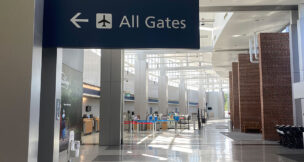Real Estate 2023: MATTHEW ‘MATT’ GANNON
Gannon joined Colliers International in his role as executive managing director and D.C. market leader in 2019. He is responsible for the strategic direction and performance of Colliers offices in Washington, D.C., Northern Virginia and Maryland, totaling more than 50 real estate professionals. He had spent the previous five years at Paramount Group, leading leasing […]
2023 Virginia 500: Real Estate
Patrick Bain PRESIDENT AND CEO, THE LONG & FOSTER COS., CHANTILLY Stephen Ballard PRESIDENT AND CEO, S.B. BALLARD CONSTRUCTION, VIRGINIA BEACH Brendan Bechtel CHAIRMAN AND CEO, BECHTEL CORP., RESTON Brian F. Bortell PRESIDENT, CHAIRMAN AND CEO, TIMMONS GROUP, CHESTERFIELD COUNTY Gary Bowman FOUNDER, CEO AND CHAIRMAN, BOWMAN […]
Serving a repurpose
In Alexandria’s Old Town North, a collection of three brick office buildings built in the 1980s is being transformed into Tide Lock, a community of 234 luxury apartments and condominiums featuring Potomac River views and space for retail and a nonprofit music school. And last summer in the city’s Alexandria West neighborhood, tenants began moving […]
Four Prince William shopping centers sell for $52.8M
A portfolio of four regional shopping centers in Prince William County’s Dale City area has sold for $52.8 million, the joint venture of buyers announced Monday. Located less than 3 miles apart along Dale Boulevard, the 1970s-era shopping centers — Center Plaza, Mapledale Plaza, Forestdale Plaza and Glendale Plaza — total 470,000 square feet on 70 […]
Bowman Consulting names new Fairfax branch manager
Reston-based Bowman Consulting Group has promoted Brad Glatfelter to manage its Fairfax County branch, the company announced Wednesday. Glatfelter joined the company as a project manager in 2014. As branch manager, he will oversee day-to-day operations, execute strategic business plans, drive utilization goals and maintain recruitment initiatives. He will also spearhead the diversification of [[...]
Midlothian shopping center under new management
A Midlothian shopping center anchored by a Food Lion is under new management after selling in late July for $19.6 million. Norfolk-based S.L. Nusbaum Realty Co. will handle leasing and management for 15-acre Village Marketplace, located at 13100 Midlothian Turnpike in Chesterfield County. The 131,814-square-foot center’s tenants include Hallmark, H&R Block, Spectrum Paint, Kabuto Japanes[...]
Henrico County, Markel|Eagle acquire land for GreenCity
Henrico County and an affiliate of Markel|Eagle Partners LLC came to an agreement Thursday to purchase the 110-acre Scott Farm property, which will be a key part of the $2.3 billion mixed-use GreenCity development, for $35.1 million. First proposed in December 2020, GreenCity plans to include what is billed as the nation’s greenest arena, with […]
$27.5M apartment community in Chesterfield now complete
Construction of a $27.5 million luxury apartment community in Chesterfield County is now complete. The Station at Chester includes 65 one-bedroom, 126 two-bedroom and 10 three-bedroom apartments with floor plans ranging from 650 square feet to 1,300 square feet. In addition to the community’s five apartment buildings, the complex includes a 4,000-square-foot clubhouse, a pool […]
$98M Richmond apartment building to break ground in Q3
A $98 million luxury apartment building, The Ace Apartments, will be the newest addition to Richmond’s Scott’s Addition neighborhood. The 1.7-acre project will have 295 luxury studio, one- and two-bedroom apartments that will average 753 square feet per unit, and 85% of the units will have balconies. The development’s plans also call for a 7,500-square-foot […]
Global coworking franchise coming to Chesapeake
Venture X, a global coworking office space franchise, is entering the Hampton Roads market, with its first location coming to Summit Pointe in Chesapeake, Cushman & Wakefield | Thalhimer announced Tuesday. HMP Properties LLC, a Venture X franchisee, has leased 18,543 square feet of space in the 555 Belaire office tower, which is part of […]
$77.8M apartments break ground outside C-ville
Charlottesville-based GW Real Estate Partners, a vertically integrated multifamily construction and development firm, and Austin, Texas-based Virtus Real Estate Capital, have broken ground on a new, $77.8 million apartment community at the entrance to North Pointe, a 224-acre mixed-use community near Rivanna Station in Albemarle County. The Ridge at North Pointe is located across from […]
Virginia MOCA moving to Virginia Wesleyan campus
The Virginia Museum of Contemporary Art is moving from Virginia Beach‘s ViBe District to Virginia Wesleyan University’s campus, with the aid of a $25 million gift, the museum and university said Tuesday in announcing the partnership. The gift, from Jane Batten, Joan Brock and David and Susan Goode, will fund construction of the museum’s new […]






















